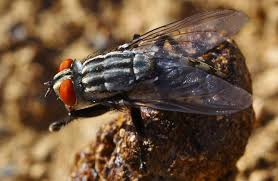Form and Function
Sarcophaga crassipalpis, as a member of the
Sarcophagidae family, is gray in color with three black stripes
on the body and a red tip on the posterior end. Adults are
marked by a black strip framed by vertical yellow bands between
the eyes (Diaz & Kaufman 2011). For more information on how
S. crassipalpis is distinguished from other species, see
Classification.
S. crassipalpis shows a degree of sexual dimorphism. Males are hairier than females. They also have stronger, more powerful legs, which allow them to dominate their mate during copulation (Diaz & Kaufman 2011). This is extremely important in S. crassipalpis Reproduction. For more information on the general anatomy of the flesh fly - as well as some incredible pictures - visit the UF IFAS Featured Creatures page.
Members of S. crassipalpis are extremely well-adapted
to their environment. As a constituent of the Insecta class, they
have a lightweight chitinous exoskeleton called a cuticle during
their larval stage (Vincent & Wegst 2004). Although not unique to
the species in question, the cuticle is integral to the success of
all flies and even insects in general. (Examples include the
flower fly and the
mayfly.) The cuticle is secreted by a
layer of epidermal cells that covers the entire external surface of
the insect. It performs roles not limited to protection: it also
provides support and shape, allows for movement, performs
water-proofing and diffusion control, and serves as a barrier
against potentially harmful organisms - parasites, vectors, and
disease-causing microorganisms (Vincent & Wegst 2004). It does all
of this despite a number of obstacles. First, the cuticle must
resist wear even through near-constant strain, especially around the
mouth. Second, it must be firm enough to provide adequate protection
to the fly’s delicate innards while still maintaining the elasticity
required for locomotion. And third, it must adapt so as not to
obstruct the senses of the insect from the external world (Vincent &
Wegst 2004). Thus the cuticle is one of the most significant
adaptations ofS. crassipalpis and of all insects.
Some S. crassipalpis pupae exhibit another incredible
adaptation: they undergo the process of diapause, a period during
which their development into adulthood is suspended during
unfavorable environmental conditions. This is also sometimes
referred to as overwintering. Larvae prepare to diapause by
burrowing into the ground before entering the  pupal stage. The pupae
can remain underground for up to six months, in the meantime facing
subzero temperatures, irregular soil moisture, and the presence of
ice (Kelty & Lee 2000). Not all members of S. crassipalpis
diapause, as those that develop during the warmer seasons have no
need, but studies show that those that do exhibit more resistance to
freezing overall. While the pupal cuticle offers little to no
freezing resistance, the puparium – basically a secondary cuticle –
contains lipids on its inner surface that prevent water loss and
help to inhibit freezing. Furthermore, the inside of puparia of
diapausing pupae is line with three times as many lipids as that of
non-diapausing pupae. However, the likelihood of a pupae
experiencing death by frigid temperatures increased with exposure
time, whether diapausing or not (Kelty & Lee 2000).
pupal stage. The pupae
can remain underground for up to six months, in the meantime facing
subzero temperatures, irregular soil moisture, and the presence of
ice (Kelty & Lee 2000). Not all members of S. crassipalpis
diapause, as those that develop during the warmer seasons have no
need, but studies show that those that do exhibit more resistance to
freezing overall. While the pupal cuticle offers little to no
freezing resistance, the puparium – basically a secondary cuticle –
contains lipids on its inner surface that prevent water loss and
help to inhibit freezing. Furthermore, the inside of puparia of
diapausing pupae is line with three times as many lipids as that of
non-diapausing pupae. However, the likelihood of a pupae
experiencing death by frigid temperatures increased with exposure
time, whether diapausing or not (Kelty & Lee 2000).
Nevertheless, non-diapausing pupae are not entirely helpless
during the cold season. Continuous freezing temperatures tend to
kill flies within twenty-five days, but even a brief exposure to
warm temperature during that time increases the survival of S.
crassipalpis. Such warmth stimulates heightened levels of ATP,
which increases the flies’ ability to perform metabolic processes
such as volume regulation and nutrient uptake. This ability to avoid
freezing even in non-diapausing pupae probably evolved because of
the flies’ regular exposure to alternating low and high temperatures
(Dollo et al. 2010)
Read on to learn more about the
Life History and Reproduction,
including a more in-depth look at the developmental stages of S.
crassipalpis.